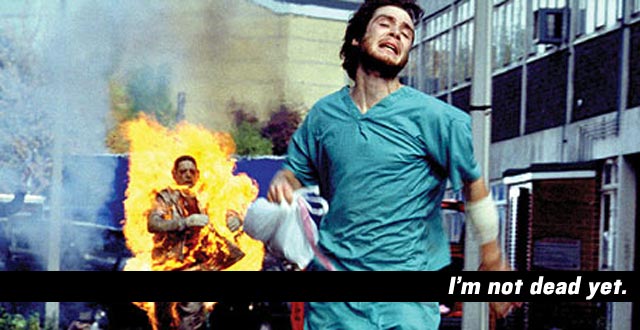Getting It Right
Upon the success of 28 Days Later, Danny Boyle was credited with revitalizing the zombie movie without really making a zombie movie (they’re “Infected,” not zombies, but we’re not going to get into such tediousness here). There’s something else he should be credited with revitalizing: the art — and the intimacy — of the low-budget horror film.
Unfortunately, when you hear the term “low-budget horror film,” what probably comes to mind is some cheap, near-unwatchable dreck you stumbled upon somewhere, something with awful acting, cheesy effects, poor lighting and incomprehensible sound. There’s definitely plenty of that kind of thing out there — everyone with a video camera and a bucket of ketchup thinks they can make a horror movie worth watching.

Smart Decisions
But horror is hard, and it’s even harder when you don’t have the resources. Sure, Danny Boyle had a bigger budget on 28 Days Later than most indie filmmakers. But he still had to challenge of portraying a post-apocalyptic world without the benefit of CGI landscapes and large-scale images of destruction.
To achieve a feeling of the end of the world, Boyle took a page out of George Romero’s book. Night of the Living Dead (1968) was made on low budget, and it’s considered one of the most atmospheric and effective horror films ever made. The trick was to create a feeling of dread and despair on a very personal and identifiable level — if you can make the audience feel that, then they’ll buy the premise that what’s happening around one single house in the woods is also probably happening everywhere else in the world. Get personal and intimate — that’s the key to a good low-budget horror movie.
Boyle certainly did this with 28 Days Later. Shooting on cheap DV cameras not only kept the budget down but also created a raw and chaotic atmosphere — DV may not look as “good” as film (and it never will), but use DV to its strengths and it can do things film can never do (and we don’t mean just being able to fit into the kind of tight corners that giant film cameras can’t). Video gives a sense of immediacy, of uncensored reality, something that also worked with The Blair Witch Project — use video right and you can make the audience really believe that most of London got wiped out by a “rage virus”… without actually seeing that large-scale devastation.
Boyle was also smart in keeping his cast small. Also like Night of the Living Dead before it, 28 Days Later keeps it tight and personal by focusing on one small group of people that become a “family,” a familiar survivalist (and human) response to a crisis. We don’t see the Prime Minister on the phone calling in an air strike. We don’t see dozens of government agents typing frantically as grim-looking executives stare at giant computer screens. We’re on a journey with regular people, just like us, and that makes the situation all the more plausible — and effective.
Sure, the scenario was expanded to a more familiar “Hollywood” approach with 2007’s 28 Weeks Later (as was the follow-up to Night of the Living Dead, 1978’s Dawn of the Dead — sort of, anyway). But before the Army was called in, there was just a bicycle messenger and his three new friends, trying to make sense of it all — just like we would.
Want More? Go ahead and Get Your Gore On
Watch this scary movie and many other Halloween favorites all month long with Movies On Demand on cable. Titles and availability may vary by cable provider. Click here to locate your cable provider.

Sponsored Post
.

Comments
28 Days Later: High-Class, Low-Budget Horror